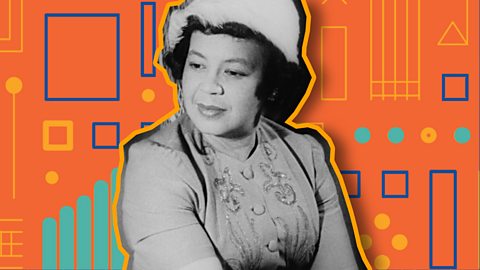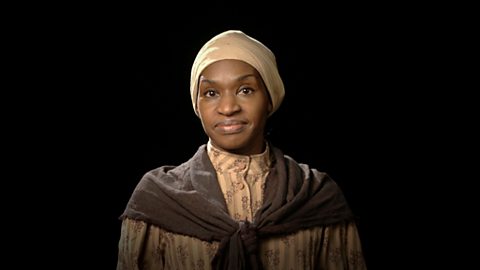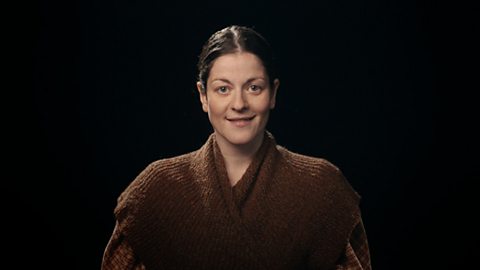ROSA PARKS:I'm going to tell you something about my life. My name is Rosa Parks. I was born in the year 1913, in the United States of America.
ROSA PARKS:What happened to me, the story I'm going to tell, well, it was such a surprise to me, really, butÔÇŽ
ROSA PARKS:Well, you'll see what I mean.
ROSA PARKS:'I grew up on a farm in Montgomery, Alabama. I had to help out around the farm, and every morning I picked up eggs laid by the chickens we kept, that ran around our front yard.
ROSA PARKS:'My grandfather, he lived with us too. And he liked to spend his afternoons sitting on the porch, snoozing in the sun or telling me stories.
ROSA PARKS:'Everything seemed just right with the world. It was a simple life, and I was happy.
ROSA PARKS:'I was just seven when I began to notice things. Things that made me think that maybe the world wasn't quite right after all.
ROSA PARKS:'My grandfather would take me into town with him. And what I started to see was that the fact that our skin was black and not white, made a difference.
ROSA PARKS:'I started to see that black people were kept apart from white people in all sorts of ways.
ROSA PARKS:'At the town hall, black, or coloured people, as we were called, and white people had separate entrances.
ROSA PARKS:'In the waiting room, we had to sit in separate seats.
ROSA PARKS:'Even when the black people seats were full, we weren't allowed to sit in the white section.
ROSA PARKS:'At the bus stop, we had to stand in line, while the white people got to sit on a bench.
ROSA PARKS:'I found it all so confusing.
ROSA PARKS:'I really didn't understand what possible difference the colour of your skin could make.
ROSA PARKS:'Everyone wore hats, went to work, ate lunch. I don't know, to me it seemed we were all the same.
ROSA PARKS:'But everyone acted like there was a difference. Like it was just the way things were.
ROSA PARKS:'We had to drink from a separate water fountain, go to a different church, use a different public toilet.
ROSA PARKS:'I grew up.
ROSA PARKS:'Still I didn't understand why the world was unjust to black people. But the government made the rules, so it seemed there was nothing we could do.
ROSA PARKS:'Like everyone else, I went along with it. I followed the rules. I used the black people's entrance, drank from the black people's water fountain,
ROSA PARKS:'went to the black people's church.
ROSA PARKS:'I got a job working in a department store. Every day, I waited for the bus, to go to work.
ROSA PARKS:'When I boarded the bus, I would sit like we always had to, at the back end of the bus. While the white people had a reserved section at the very front.
ROSA PARKS:'If the white seats were full, we had to give up our seat when a white person got on, even if that meant standing up all the way.
ROSA PARKS:'It wasn't fair. But those were the rules, and like most people, I just did what I was told and didn't make a fuss.'
ROSA PARKS:It was December 1st, 1955.
ROSA PARKS:I don't know why it happened on this day, it was a day like any other.
ROSA PARKS:It had been a long day at work and I was eager to get home, take off my shoes and rub my feet. It was a day like any other.
ROSA PARKS:I didn't know, when I boarded the bus that afternoon, that I was going to do what I did.
ROSA PARKS:'I took my seat in the row behind the white people seats. The white rows were full, when another white lady boarded the bus.
ROSA PARKS:'I stayed put.
ROSA PARKS:'I felt myself rooted to the spot just like a tree.
ROSA PARKS:'Somehow, in that moment, I'd made up my mind.
ROSA PARKS:'The white people in front of me tutted and shook their heads.
ROSA PARKS:'I felt the black people behind me sit up a little straighter, keen to see what would happen next.
ROSA PARKS:'The bus driver left his seat.
ROSA PARKS:'But still, I didn't budge.
ROSA PARKS:'Somehow, I'd made up my mind.
ROSA PARKS:'The white people in front of me tutted and shook their heads, I felt the black people behind me lean forward to see who it was that had dared to disobey the rules.
ROSA PARKS:'The police came. But still, I didn't budge.
ROSA PARKS:'I'd never made a fuss before, I'd never broken any rule, let alone been arrested. But somehow, I'd made up my mind.'
ROSA PARKS:People said afterwards that I refused to give up my seat because I was tired.
ROSA PARKS:True, it had been a long day and my body ached.
ROSA PARKS:'But that's not why I refused to stand. No. The only tired I was, was tired of giving in.
ROSA PARKS:Tired of being treated differently, like a second-class citizen, on account of the colour of my skin.
ROSA PARKS:Everyone else I knew was tired of it too. It was just we didn't know what to do about it.
ROSA PARKS:My little act of defiance, my refusal to give in, it was a small thing to do.
ROSA PARKS:I just wanted, for once, to be able to sit where I sat, and to not have to give upmy seat to someone else just because she was white.
ROSA PARKS:It was a small thing to do.
ROSA PARKS:But it was what happened afterwards that really mattered.
ROSA PARKS:'Without knowing it, I'd started something.
ROSA PARKS:'That very evening, news of my tiny protest got around.
ROSA PARKS:'People got together and called anyone they could think of. They wanted everyone to know what I had done.
ROSA PARKS:'It was as if they had all been waiting for a chance to do something. And my simple refusal to stand up on a bus one afternoon had given them that chance.
ROSA PARKS:'Plans started to form for a bus boycott. The ideas was, that on the Monday when my case would go to court, all the black people in Montgomery should walk to work and refuse to take the bus.
ROSA PARKS:'That way, the bus company would lose money. And that way, people would see that I wasn't the only one who was tired of giving in. Tired of being treated badly.'
ROSA PARKS:Monday 5th of December was the day of my court case.
ROSA PARKS:I was found guilty of not following the rules and fined $14, which was a lot of money in those days to someone like me.
ROSA PARKS:But it didn't matter. What did matter was what was going on outside.
ROSA PARKS:'Most of Montgomery's 40,000 black workers, and some white people too, didn't take the bus to work or school.
ROSA PARKS:'Some walked, some shared cars, some rode bicycles. They wanted to show the world that they had all had enough. They marched through the street, and there was so many of them it was impossible to ignore.
ROSA PARKS:'The buses were almost empty.
ROSA PARKS:'The protest continued long after I'd paid my fine and gone back to my job.
ROSA PARKS:'All together, people stayed off the buses and walked to work for 381 days.
ROSA PARKS:'It became a powerful symbol that we were tired of giving in.'
ROSA PARKS:The newspapers wrote about the protest. People all over America could see what was going on.
ROSA PARKS:Eventually, the government had to do something.
ROSA PARKS:They made a new rule. Black people no longer had to sit in a separate section of the bus.
ROSA PARKS:We would never again have to give up our seats to someone just because they were white.
ROSA PARKS:Black people and white people were still kept separate in other ways, but it was a start.
ROSA PARKS:A step towards equality and justice.
ROSA PARKS:I was just an ordinary person, and I was amazed at what I'd started.
ROSA PARKS:I was so glad that on that day I made up my mind and I refused to budge.
Video summary
Rosa Parks tells the story of her life, showing how her refusal to give up her seat to a white person on a segregated bus changed the rules of American society, and led towards equality and justice for everyone, whatever the colour of their skin.
The story is told in the first person, and brought to life with a mix of drama, movement, and music.
Growing up in Alabama, Rosa struggled to understand why black and white people were treated differently.
One day Rosa refused to give up her seat to a white person just because she was black.
This small act changed American society forever.
Teacher Notes
Questions to consider whilst watching the film
Depending on the focus of your lesson, you may wish to ask the following questions after the video or pause the short film at certain points to check for understanding.
- Rosa Parks says in the video she was happy up to the age of seven. Why was her early childhood a happy one?
- In what ways were black Americans treated differently to white Americans in Rosa ParksÔÇÖ local town?
- Why did the young Rosa Parks not understand this different treatment?
- What do we learn from the video about what happened on 1st December 1955?
- It was claimed that Rosa Parks refused to give up her seat because she was tired, but she said it was because she ÔÇśwas tired of giving inÔÇÖ. What do you think she meant by this?
- What was remarkable about the Montgomery bus boycott?
Learning activities to explore after the video
History is a subject which can lend itself to a wide range of cross-curricular links. As a teacher, you will have a greater awareness of how this topic may act as stimulus for learning in other subjects. However, the suggestions below relate to ways of developing the childrenÔÇÖs historical knowledge and understanding.
Key Question: Why is Rosa Parks an important figure in the history of Civil Rights?
Diversity of society and a wider historical perspective
The story of Rosa Parks, like the story of Harriet Tubman, provides opportunities for teachers to teach a more diverse and inclusive history. It is equally important not to teach the story of Rosa Parks in isolation; beside the criticism of tokenism, this is a topic which critically needs to be placed in a wider historical perspective.
Margaret Bonds - March and Dawn from Montgomery Variations
Get to know two variations from Margaret Bond's 'Montgomery Variations', inspired by Rosa Parks and the Montgomery bus boycott that became a catalyst in the American civil rights movement.

The difficulty facing teachers is how much historical background you are able to cover in the time available. Studying this topic in conjunction with the guide for Harriet Tubman will mean that the class has some background on slavery; if this does not happen, then the class will need an overview of how African-Americans had been treated from slavery through reconstruction up to the time of the Civil Rights movement for 1950s and 1960s. This is covered in a 91╚╚▒Č Bitesize guide on The Civil Rights Movement in America. Although aimed at Key Stage 3, much of the text would be accessible to younger children, though they would not necessarily need some of the more specific factual information.
It is very important that pupils are aware of the Jim Crow laws and appreciate that segregation on buses was but one of the many indignities African-Americans had to face. This issue is explored well in the video. The Path to Civil Rights page has a series of images of other events at the time and so Rosa Parks and the Montgomery Bus Boycott can be seen alongside other key protests.
Irrespective of the amount of historical detail the class has, the concluding phase of the lesson needs to be an assessment of why Rosa Parks is an important figure in the history of Civil Rights. In doing so, it is important for pupils to see that history is complicated and that this one event did not in itself lead to integration. As the notes on this 91╚╚▒Č Bitesize guide explain, ÔÇśwhite-only restaurants and theatres still existed in Montgomery and across all the southern states.ÔÇÖ
Historical enquiry
As this is a relatively recent event, a good range of primary sources about it can be found on the internet, especially from the United States. has a primary source set of sources just on Rosa Parks as well as a complementary set focusing on . Teachers could browse and choose any of the documents for use in their classroom. However, if there is only time to explore one of the sources, there is one powerful document to use in conjunction with this video and that is . The first page is suitable for a primary classroom and although the whole document is just four pages (with just a few sentences on each page), teachers may feel that some of the later content is not appropriate or accessible for their children. There is also a which can be downloaded.
The American National Archives has a number of for interrogating primary sources, aimed at different levels and these could be used in conjunction with any of the sources used. In addition, it has an and there are two interesting sources about Rosa Parks: and a . In both of them, the crucial details about Rosa Parks have been blacked out and so one or both of these ÔÇśmystery sourcesÔÇÖ could be studied in another lesson for recapping and reinforcing historical knowledge.
Learning aims or objectives
England
From the history national curriculum
Pupils should:
- develop perspective and judgement.
- gain historical perspective by placing their growing knowledge into different contexts.
- understand the methods of historical enquiry, including how evidence is used rigorously to make historical claims.
Northern Ireland
From the statutory requirements for Key Stage 2: The World Around UsLinks can be made to other Learning Areas:
- by researching and expressing opinions and ideas about people and places in the world around us, past, present and future.
To provide a balance of experiences in History pupils could study:
- Places then and now and how our identity, way of life and culture has been shaped by influences from the local and wider world.
Scotland
From the Experiences and Outcomes for planning learning, teaching and assessment ofSecond Level Social Studies:
- I can compare and contrast a society in the past with my own and contribute to a discussion of the similarities and differences.
- I can use primary and secondary sources selectively to research events in the past.
Wales
From the new Humanities Area of Learning and Experience
School curriculum design for History should:
- develop rich content across the time periods.
- expose learners of all ages to a range of historical periods on a local, national and global scale.
- develop historical ÔÇŽ source-based skills.
- develop rich content across the time periods, through which learners can develop an understanding of chronology through exploring ÔÇŽ the use of evidence.
Principles of progression
Descriptions of learning for Progression Step 2
Enquiry, exploration and investigation inspire curiosity about the world, its past, present and future:
- I can collect and record information and data from given sourcesÔÇŽ
Human societies are complex and diverse, and shaped by human actions and beliefs:
- I have explored and am aware of diversity in communities.
Harriet Tubman. video
Harriet Tubman explains how she escaped slavery and then helped others to do so.

Grace Darling. video
Grace Darling describes the night she and her father rowed out in a boat to save sailors.

Florence Nightingale. video
Florence Nightingale tells the story of her life and how she grew up to become a nurse.
